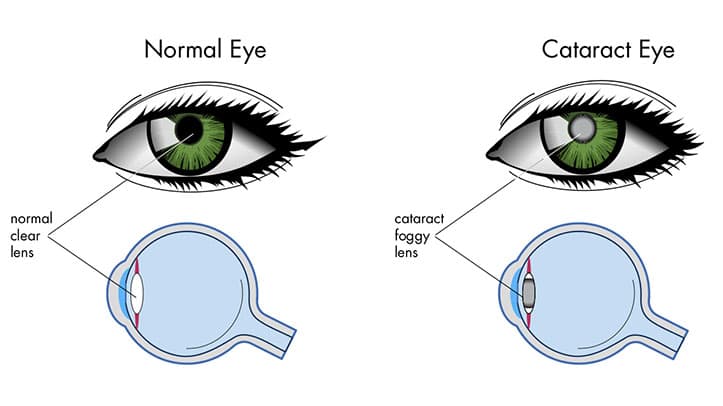As eye doctors, we see cataracts every day, and patients are often afraid when they learn they have them. They remember seeing their parents or grandparents have cataract surgery and maybe not receive the best outcome. As optometrists, we try to put patients’ minds at ease, letting them know that the procedure has made significant advancements. My goal with this article is to relax your mind about cataracts.
What are Cataracts?
Cataracts are a clouding of the natural lens inside your eye. The lens sits right behind your iris and starts
out clear when we are born. The lens is important in helping focus light onto your retina, the back
portion of your eye, for images to be clear. They typically form in both eyes but can be worse in one
than the other.


Who gets them?
I like to say that everyone gets cataracts if they are lucky to live long enough! Cataracts mostly develop
in patients over 40, but anyone can get them. Some babies are even born with them! These are called
congenital cataracts and are due to abnormal lens development during pregnancy. Although most
people start to get them in their 50s, they are typically slow to develop. About half of Americans have
surgery by the age of 80.
What causes cataracts?
Aging changes within the eye is the number one cause of cataracts, but many other things contribute.
UV exposure can cause cataracts to develop or worsen, so make sure to wear your shades when you are
outside! Long-term use of steroids is also known to cause cataract formation. Many of my patients
struggle with diabetes and that can make cataracts worse as well. They can also form from injuries to
the eye. There are others, but these are the main ones that I see in the office.
What are symptoms of cataracts?
Overall blurred vision is one of the main symptoms of cataract development. As you can imagine, if the
lens is cloudy, the images that are focused onto the retina will be unclear. They also cause significant
glare and halos around lights. This can make it extremely difficult to drive at night. Colors can also start
to appear more faded. A lot of my patients mention that they didn’t realize how dingy everything looked
before they had their cataracts removed. All these symptoms can have a drastic effect on the ability to
do normal everyday tasks such as reading, driving, and even walking.
How are cataracts diagnosed?
Cataracts are typically diagnosed with an annual dilated eye exam. When we dilate the eye, the pupil
gets bigger which allows us to see through to the lens and determine the grade of the cataract (i.e. how
bad it is). We also check visual acuity to see how well the patient can see. At early stages of cataract
formation, we can usually get vision better with new glasses. If the acuity is poor with best correction or
glare is significant, we typically recommend cataract surgery to improve vision and quality of life.
How are cataracts treated?
Cataracts must be surgically removed by an ophthalmologist. It is one of the most common and safest
surgical procedures performed here in the United States. In most cases, the surgery is performed on one
eye and then the other eye a few weeks later. The surgeon will remove the natural lens and replace it
with an artificial lens. For most patients, this lens will correct distance vision but will require reading
glasses. If you have astigmatism (a topic for another day), you may need a different lens to fully correct your vision.
There are also multifocal lenses that can correct distance and near vision, but these may not
be an option for every patient. The surgeon will go over all these options in depth.
Overall, cataracts are a normal part of life that we will all deal with eventually. If you have any questions
about cataracts and whether you have them, we would be happy to talk to you about that! If you are
over 65, it is so important to get annual dilated eye exams so that we can monitor the progression of the
cataracts and determine when the right time for surgery is.
